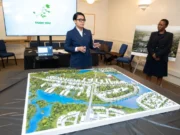The Bureau of Statistics and Digital Technologies Group of Companies Inc today signed a GYD$219,784,200 contract for the supply and delivery of 2400 Computer Tablets and accessories to be utilized for field data collection during Guyana’s 2022 Population and Housing Census.
Signing on behalf of the Bureau during the ceremony hosted in the Boardroom of the organisation’s Main Street, Georgetown headquarters was Chief Statistican, Errol La Cruez.
According to him, the contract has significant implications for the conduct of the Census, since this will be the first time that a national data collection exercise will be computer-based. By taking this step, the Bureau is embracing the application of available technology, he said.
The Chief Statistican added that the Computer Tablets are a critical part of the Census, since they will facilitate faster data capturing, reporting and analysis in order to produce quality data in record time. This data will guide and provide support for development planning and general analysis across Guyana.
Signing on behalf of the supplier was Senior Operations Manager, Jennifer Persaud who noted that it was a pleasure serving the Bureau’s digital technology needs.
She expressed hope that the devices will meet the needs of the organisation and that the execution of the Census will be successful.
A total of nineteen (19) bids were received following the advertising of the open/public tender which was executed through the National Procurement and Tender Administration Board (NPTAB).
Digital Technologies Group of Companies Inc emerged successful for the supply and delivery of the Computer Tablets and accessories.
The Census, Guyana’s largest national data collection exercise, is being planned for commencement in mid-September, 2022.
This is an extremely important exercise that produces a large amount of socio-economic and demographic data that is used for planning and national development. It is conducted every ten years and Guyana’s last Census was conducted in 2012.
The Census plays a critical role in evaluating changes in the population and therefore should be viewed as more than just a headcount. These changes include size, composition, economic activities, quality of life, access to basic social services, Maternal Health, food security, Agriculture and Education.
All of these changes have an impact on the demand for social services, such as health, housing & education. This information is in great demand by the policy makers for planning and development, private sector, students, researchers and international agencies.













